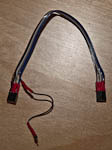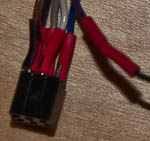I use the mega-isp solution mentioned above - the Arduino avrisp sketch is here
http://code.google.com/p/mega-isp/downloads/list
I do not use the shield they have - I made up a simple cable using two 6 pin dual-in-line header sockets to fit the programming ISP connector on your Arduino. (I did not have two dil sockets so I used standard single in line and superglued two 3 pin sockets together.
You then need a piece of ribbon cable or some wire.

Connect each pin on one socket the the corresponding one on the other, with the exception of pin 5 = Reset.
Connect one end of the cable to pin 5 - this is the end that will connect to the target AVR that you wish to program. Connect the other end of the pin 5 wire to a floating pin connector.
To use connect the cable to the arduino by placing over the ISP programming connector and connecting the floating lead to digital 10, connect the other end to the target ISP connector. You need to ensure that the pin 1's match up.


Program with avrdude using
avrdude -P com7 -p t2313 -c avrisp -b 19200 -U flash:w:fred.hex
where
com7 - the com port that the Arduino based programmer is on
t2313 - the type of AVR you wish to program (m328 for ATMega328).
fred.hex - the name of the hex file you wish to progam into the target.
I have used this to program Tiny2313 with no problems.
Note: The cable will carry 5v to power the target - if the target is already powered then do not connect pin 2 of the cable.



Best Answer
Yes and no. I've been developing on the AVR32 for a particular project, and the development environment (in particular the compile/program/debug cycle) is horrendous compared to, for instance, PIC32.
The customers don't care, except for cost and maintenance, and in the case of an arduino-like system the programmers wouldn't care because the arduino environment and development cycle is leaps and bounds better than the current AVR32 setup.
There's no reason another processor couldn't be used, but there's a very good reason they've chosen a low end 8 bit device rather than an ARM, MIPS, PowerPC, etc device: Ease of use.
If you've looked at the setup for the even the low end arms, it's an order of magnitude more complex (memory mapping, caching, etc) than an 8 bit processor. But even more importantly - at the time there were no DIP arm processors, and these were meant to be used and buildable by artists and hackers, not necessarily electronic technicians and engineers who feel comfortable with even a 48 pin TQFP.
The reason the AVR was chosen over the PIC is that the PIC doesn't really have a widely used, open source, free C compiler, among other things (the SDCC port isn't mature).
Mainly it's due to ease of use - complexity, easy to solder, cost, and the fact that there's not much need for it. Developers like the idea of having a lot of power, but at the end of the day when all you need to do is move some servos and flash some lights with a low-end FFT, an 8 bit processor is just fine.
Even the low end cortex ARMS coming out in 28 pin packages are still SOIC, not DIP.
So the AVR had all the right features:
Largely this is still true - I don't know of an ARM in a dip format, and the adapters make it significantly more expensive than the AVR. For the most part, manufacturers don't think that a DIP packaged 32 bit processor is going to be very profitable.